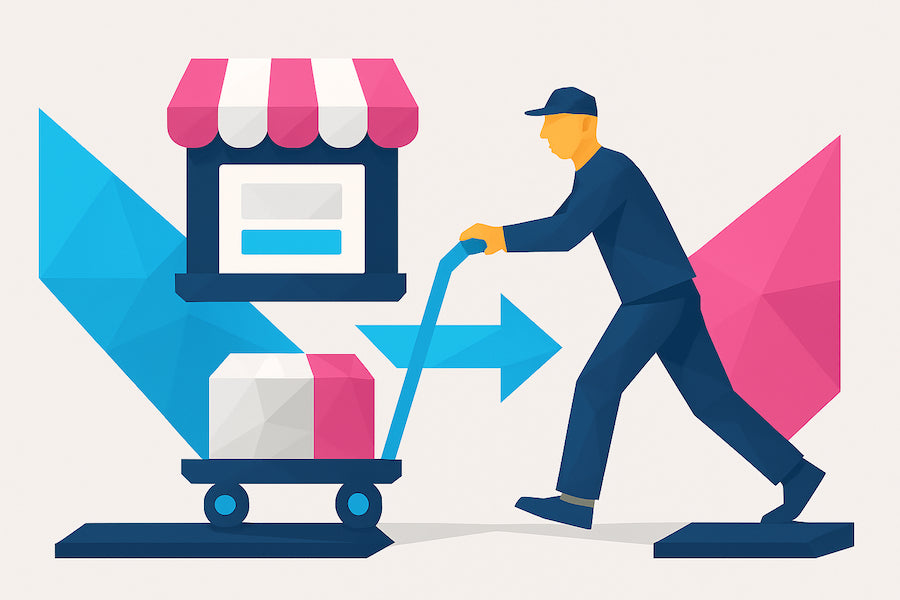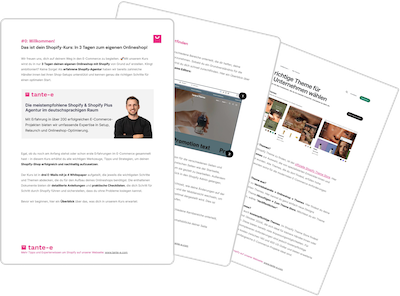A platform switch to Shopify is the next logical step for many e-commerce brands, especially when existing systems reach their limits. Whether due to technical limitations or the desire for more flexibility, switching to Shopify often offers brands a modern, scalable, and low-maintenance solution.
Reisenthel demonstrates how this transition can be implemented in practice. Together with us, the long-established company successfully implemented the switch from Shopware to Shopify, including a customized storefront, restructured product data, and CMS integration.
In this article, we provide insights into the project, explain the typical phases of a Shopify migration, and highlight what's really important when switching platforms. The content is based on the knowledge of our expert Tobi, who accompanied Reisenthel on the relaunch journey.

Project manager Tobi at tante-e has already supported numerous brands in their migration to Shopify and implemented high-quality store setups. He shares insights from his work on the Reisenthel store in the tante-e podcast ( YouTube , Spotify & Apple Podcasts ).
Our checklists & guides: Everything you need to get started with Shopify 🚀
1. Why brands are switching to Shopify
A platform change is usually not an end in itself, but a response to specific limitations in the existing setup. In Reisenthel's case, for example, the trigger was the end-of-life of Shopware 5, which would no longer receive security updates. The question was: continue development with Shopware 6 or rebuild with Shopify?
The decision fell on Shopify – for the following reasons:
Advantages of Shopify from a brand perspective:
| Advantage | Importance for the team |
|---|---|
| Scalability & Performance | Stability and speed – even with high traffic |
| Flexibility in handling | Changes in the shop can be implemented without technical know-how |
| Intuitive user interface | Facilitates onboarding of new team members |
| App ecosystem & extensibility | Fast integration of new functions without complex custom development |
| Strong community & partner network | Access to expertise & proven tools |
These aspects were particularly relevant for Reisenthel, as the e-commerce team wanted to gain more independence in store management. Instead of requiring external support for every minor adjustment, the storefront should be able to be flexibly maintained and developed internally.
The modernization of the system landscape also played a role in the background: A new CMS was introduced in parallel with the new shop. Shopify's openness to interfaces, structured data (e.g., meta fields), and custom templates was an important factor here.
2. Platform change: Our proven approach
The first step is to comprehensively analyze the existing e-commerce landscape, rethink requirements, and migrate to Shopify in a future-proof setup. To achieve this, we at tante-e rely on a structured approach with clearly defined phases that can be flexibly adapted depending on the project goal and complexity.
2.1. The five phases of a platform change
1. Concept phase
The most important building block of every project. Here we analyze together with the brand:
- What are the requirements (must-haves / nice-to-haves)?
- Which processes, systems and interfaces need to be taken into account?
- Which use cases, target groups and content structures characterize the shop?
On this basis, we develop a realistic setup, prioritize functionalities and define the roadmap for implementation, including technical dependencies, team roles and material requirements.
2. Material phase
Here, our customers prepare all the content needed to set up the new shop:
- Product data, images, texts
- Brand guidelines, design specifications
- References & inspiration for the future storefront
This is an often underestimated effort, especially with extensive product portfolios or when system changes (e.g. ERP or PIM) are initiated.
3. Design phase (optional, depending on setup)
For a custom approach or when certain elements can't be covered by a theme, the design phase follows. Here, we create:
- individual storefront sections
- specific landing pages
- UX concepts based on the defined requirements
The goal is to make the brand identity tangible without losing sight of conversion.
4. Implementation (Development)
Now it’s time to set it up:
- Technical setup in the Shopify backend
- Implementation of the storefront (theme-based or custom)
- Integration of apps, features and interfaces
- Testing, fine-tuning and final preparation for the launch
5. Launch & Training
At the end of the project, we ensure that the internal team can continue to maintain the shop efficiently:
- Training on Shopify, meta fields, product maintenance, etc.
- Documentation of workflows
- Support during the live launch and beyond
2.2. Two ways to achieve the goal: theme-based or custom?
Depending on the requirements, we distinguish between two approaches:
| Approach | Description | Advantages | When is it useful? |
|---|---|---|---|
| Theme-based | Structure based on a premium theme | Fast, cost-effective, modern | Suitable for many shops if no complex special functions are required |
| Custom approach | Building your own modular system (e.g. based on Dawn) | Fully flexible, individually customizable | For special requirements, e.g. many A/B tests, specific product logic, strong brand aesthetics |
At Reisenthel, the decision was deliberately made to use the custom approach in order to transfer existing learnings from A/B tests into the new shop and maintain maximum design freedom.
3. How difficult is it to switch platforms to Shopify?
A platform change affects far more than just the frontend. For brands, it entails organizational and technical changes that require careful preparation. Crucially, the clearer the brand's understanding of its requirements and system landscape, the smoother the project will run.
To ensure that brands get off to the best possible start, we prepare them specifically for the next steps during the concept phase.
3.1. What brands should prepare
-
Document requirements
- What functionalities does the new shop need?
- What is essential, what would be desirable?
- Which processes should run more efficiently in the future?
A written requirements document or specification helps to clarify these points at an early stage.
-
Understanding systems and processes
- Where is product data currently located?
- Are there existing ERP, PIM, or CMS systems?
- Which interfaces need to be created with Shopify?
A clear overview of the system landscape is essential to ensure efficient data exchange.
-
Plan content & materials
- Images, texts, icons, videos, look & feel
- Existing brand guidelines and design components
- References, inspiration examples, A/B testing insights
Especially when it comes to content, it’s worth consciously thinking anew – not everything has to be copied 1:1.
3.2. Typical challenges – and how we address them
| Challenge | Meaning | Our solution |
|---|---|---|
| Product data is not directly transferable | Data structures do not match the new logic in Shopify | Joint structuring of data, use of metafields, close coordination with external system partners |
| System landscape is complex or changing | Migration meets new tools or individual interfaces | Early analysis & technical coordination with all stakeholders |
| Lack of Shopify knowledge in the team | Makes independent work difficult after launch | Training & accompanying enablement formats by tante-e |
| Unclear responsibilities on the customer side | Delays decisions and material deliveries | Joint project setup with clear roles & milestones |
4. Case Study: How Reisenthel switched from Shopware 5 to Shopify
Reisenthel is a traditional company with over 50 years of history and is best known for functional bags, shopping baskets, and design classics such as the "Muttikorb" (Mummy Basket). The starting point for the project was an active online shop on Shopware 5, whose support was discontinued in July 2024. The key question: a switch to Shopware 6 or a migration to Shopify?
Reisenthel deliberately chose Shopify for strategic and operational reasons. The goal was a future-proof, flexible store that the team could manage independently, without technical hurdles or dependence on developers for day-to-day changes.

4.1. Project start: Workshop, concept phase & custom setup
The starting point was a joint workshop on-site at Reisenthel. Based on this, the concept phase defined:
- What are the requirements from previous A/B tests?
- Which modules and sections are needed for the new storefront?
- How should the data structure in the new CMS and the shop work together?
The decision was made to implement a completely customized Shopify setup based on a custom approach. The goal was maximum flexibility while maintaining clear branding.
4.2. Technical challenges & solution
A key focus was the integration of a new system landscape parallel to the store relaunch. Through targeted use of Shopify metafields, all necessary product information could be dynamically and clearly integrated into the storefront.
Additionally, a clean migration of order data and customer information was performed. Proven tools such as Matrixify and specialized apps for vouchers and discount codes were used. Passwords could not be transferred in compliance with GDPR, but were automatically created via invitation.
4.3. Implementation & Timeline
| phase | Length of time | Contents |
|---|---|---|
| Concept phase | approx. 4 weeks | Requirements definition, module catalog, system comparison |
| Design & Setup | approx. 8 weeks | Modular storefront, templates, theme development |
| Integration & Testing | approx. 6 weeks | Data migration, app setup, QA |
| Training & Launch | 2 weeks | Enablement, go-live support |
4.4 Results & Outlook
With the launch of the new Shopify store, Reisenthel was able to:
- Seamlessly integrate all relevant content, data and processes
- Individually reflect the existing brand aesthetics
- Empower internal teams to maintain the shop themselves
- Create a technical basis that can be expanded in the long term
Since going live, we've been continuously developing the shop, including new bundle logic, additional product page templates, and regular A/B testing. The platform switch was therefore not just a technical project, but the starting point for a more flexible, future-oriented e-commerce experience.
5. Conclusion: When do we recommend switching to Shopify?
A platform switch isn't an easy step, but it can be worthwhile if the conditions and strategic planning are right. Shopify offers a powerful foundation, especially for brands that want to operate independently, scalably, and in line with their brand over the long term. Reisenthel's case study demonstrates how such a project can be successfully implemented even in complex circumstances.
When Shopify is the right choice
Switching to Shopify is especially worthwhile if:
-
Shop technology is outdated
e.g. no more security updates like with Shopware 5 -
Flexibility is desired
e.g. the internal team should be able to adapt content themselves -
Scalability is an issue
e.g. growing product range, international orientation -
UX and conversion should be specifically optimized
e.g. through individual templates, A/B tests, personalization -
Technical complexity should be reduced
e.g. through targeted CMS integration, modular storefronts
What is crucial for success
A successful platform transition depends not only on the technology itself, but also on the way it's implemented. In our experience, these factors are crucial:
- A clear project plan with a realistic timeline
- A detailed concept phase
- Reliable contacts on the brand side
- Early involvement of all system partners and stakeholders


